INVESTIGATION… Despite billions budgeted, Ebonyi students sit on stones under thatched roofs to learn
With 57 percent rate, Ebonyi state has the highest number of out of school children in the southeast. The state government in 2017 and 2018 allocated over N2 billion each to the Ministry of Education and the Ebonyi State Universal Basic Education Board (SUBEB) for the development of education in the state. Despite this, primary schools in the state remain in shambles.
In this investigation, Kelechukwu Iruoma travelled to Ebonyi and visited primary schools in four local governments areas across the three senatorial zones to report on the dilapidating state of primary schools in the state.
It was sunny on a Wednesday morning in mid-October. It was the week before the government schools across Ebonyi, a state in southeast Nigeria, would go for the mid-term break. While teachers were working harder to meet up with the curriculum, pupils were rejoicing they would have two extra days to spend at home.
At schools in major towns in the state like Abakaliki, Afikpo, and Unwana, the break comes once in a term, or when there is a strike. But for schools in rural areas like Abonyi Okpoto, Okpomoro Oshiegbe, “no school” is a norm. It happens twice a week.
The sight of the camera and the constant sound of the shutter drew the attention of the Nursery pupils of Practical Primary School, Igbeagu in Izzi local government. While some of the pupils sat on a mat, others sat on the floor and planks from broken tables.
The majority of them had no school uniforms and some of them were barefooted. All these were never the kids’ concerns. Deep inside, they were not happy but the sight of the camera made the difference at that point in time.
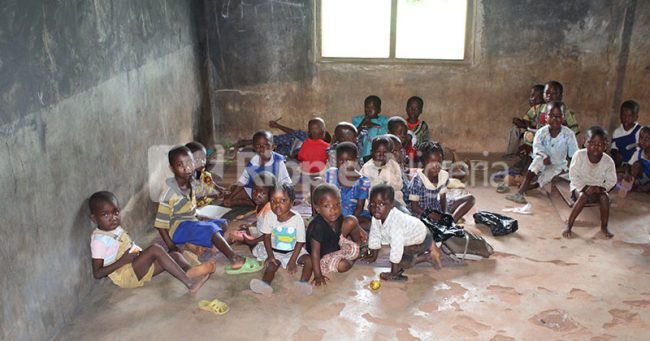
Pupils of Practical School Igbeagu in Izzi local government sitting on the floor due to lack of seats
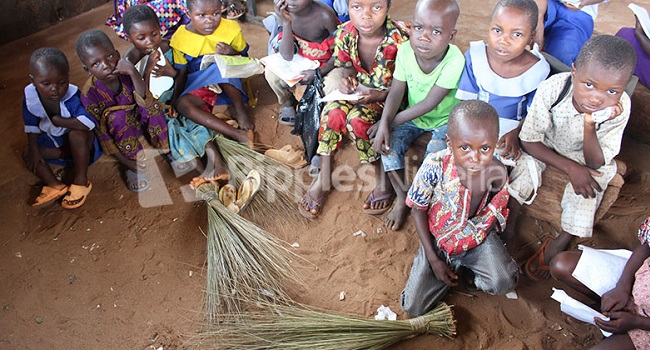
Pupils of Practical School sit on the floor to learn
Seating on the floor to learn is what pupils and teachers in primary schools face in Ebonyi state.
High rate of out of school children
According to a survey by the Multiple Indicator Cluster Survey (MICS 2011) in collaboration with the United Nations International Children Education Fund (UNICEF) and National Bureau of Statistics, 57 percent of school-aged children in Ebonyi state are out of school, making it the state with the highest number of children out of school in the southeast.
As a result, UNICEF in collaboration with the Ebonyi State Universal Basic Education Board (SUBEB) initiated an Enrolment Drive Campaign across the 13 local government areas in the state to sensitize children and parents about education.
This reporter visited schools in four local governments across the three Senatorial zones comprising Ebonyi South, Ebonyi Central, and Ebonyi North. While many parents and teachers are not aware of the Enrolment Drive Campaign initiated by UNICEF in collaboration with SUBEB, there is a clear improvement in primary school enrolment, the reporter can confirm.
Hardly would school children be found during school hours at home, or on the streets playing. School children ranging from three to 12 years were seen trekking for about three hours to and from schools to acquire education. Even without footwears, they still find the need to go to school.
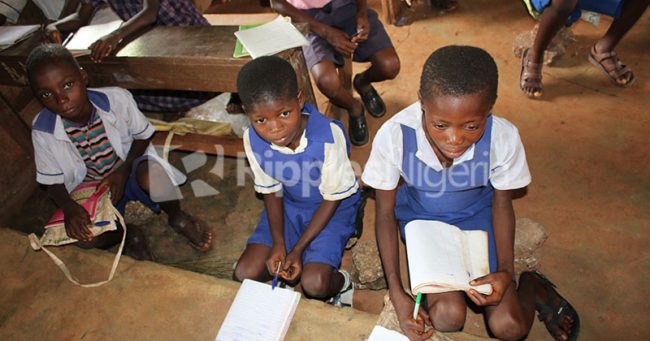
No seats! Students now seat on broken concrete blocks without backrest
The state government in its 2017 and 2018 budget allocated over N2 billion for the Ministry of Education and Ebonyi State Universal Basic Education Board (SUBEB). However, there are schools in the communities visited that lack infrastructure and teachers who can deliver quality education. Every primary school visited had no more than two teachers, resulting in the merger of classes.
Some schools have only one teacher while in other schools, community leaders employ community teachers to teach the pupils. This shows the level parents go to ensure their kids are educated.
Merger of classes due to lack of teachers
“There are 300 pupils in the school. “Two classes are merged with one teacher teaching the two classes, and each class has up to 40 pupils,” says Evelyn Nwailo, the headmistress of Practical Primary School Igbeagu.
“Pupils in the school seat on the floor and many of them do not have uniforms because their parents cannot afford to get them a uniform. So it is difficult to wear a uniform in this school,” she continued.
In a standard school, there should be water, toilet, seats, and textbooks, but the school lacks all these. “There is no clean water. Students drink unclean water from the stream,” Nwailo laments, sitting in her office where only a chair and a table exist.
At Ojiegbe Primary School 1 and 2 in Izzi local government, the situation is worse. The school building and roof have collapsed. In order not to shut the school completely, the school authorities decided to use bamboo palms as roof. The school lacks seats as pupils use concrete blocks as seats.
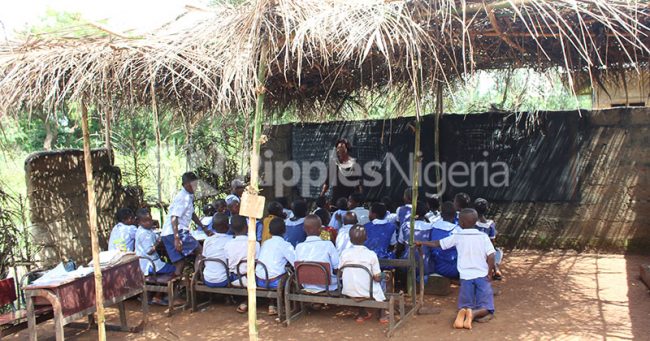
A teacher of Ojiegbe teaching under the bamboo palm after the school building collapsed
“There are no seats for them to sit as the pupils sit on the floor,” says the school’s headmistress, Juliana Nwafor. “Two classes are merged and one teacher teaches three classes as the school has only two teachers.”
Despite being established in 1945, the school is yet to be renovated or a new building constructed for the community. A building constructed by the community for the school, collapsed early this year. It is now abandoned. Nwafor was posted to the school in January 2018, and according to her, she was sad seeing the state of the school. The school had no headmistress’ office.
No building, school now uses bamboo palms as roof
With her money, she built two offices for herself and her colleague in school 2. Subsequently, the two schools wrote to the SUBEB requesting for classrooms building project and teachers. In the letter dated December 15, 2018, and signed by the two headmistresses and the Parents Teachers Association (PTA) Chairman, when the school building built by the community collapsed, it put the lives of over 100 pupils under it at risk.
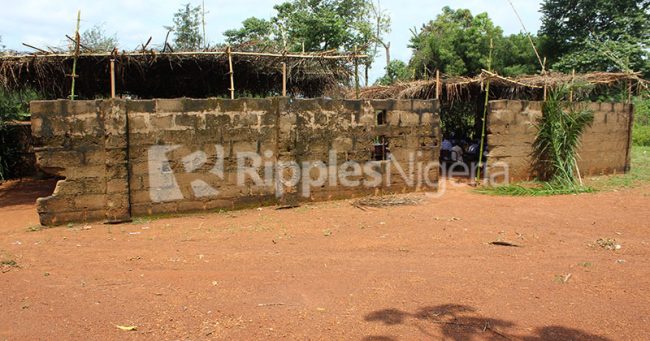
school turned bamboo school in Ojiegbe Primary school
After 10 months, the schools have not heard from SUBEB as students and teachers keep suffering in the quest to learn and provide quality education.
According to Nwafor, the two schools have 1,200 pupils with no standard building. “You can see that we don’t have buildings. The pupils receive classes under the mango trees without chairs. We have written and sent photographs to the Executive Chairman of SUBEB but we have not been answered.”
She said she has also visited the SUBEB office in Abakaliki severally, yet, no positive response. “Even the community has made no efforts to assist us. Pupils in the environment go to school but we lack instruments that can deliver quality education,” Nwafor lamented.
“We don’t have enough teachers. We have only five teachers in school 1 and school 2. There are schools where they only have one teacher and one community teacher.”
Pupils turn to teachers
Nwafor’s claim was confirmed in Negede Migrant Primary School at Okpomoro Oshiegbe in Ezza North local government area. Negede is a small community, and in the course of the trip around the community, no kid was found playing, during school hours.
As the reporter alighted from the motorcycle, two feminine voices were heard reciting “parts of the body,” a topic in Health Science. As they raised their voices, other pupils responded. Bethel Nwoke and Kasarachi Odinaka in primary four were the pupils who have turned teachers. They were in their sportswears while other pupils wore house clothes. Nwoke and Odinaka are the brilliant pupils carrying other pupils along.
The school only has two teachers ‒ the headmaster and one other teacher ‒ and a community teacher whose service was employed by the community leaders to contribute to the educational development of children in the community.
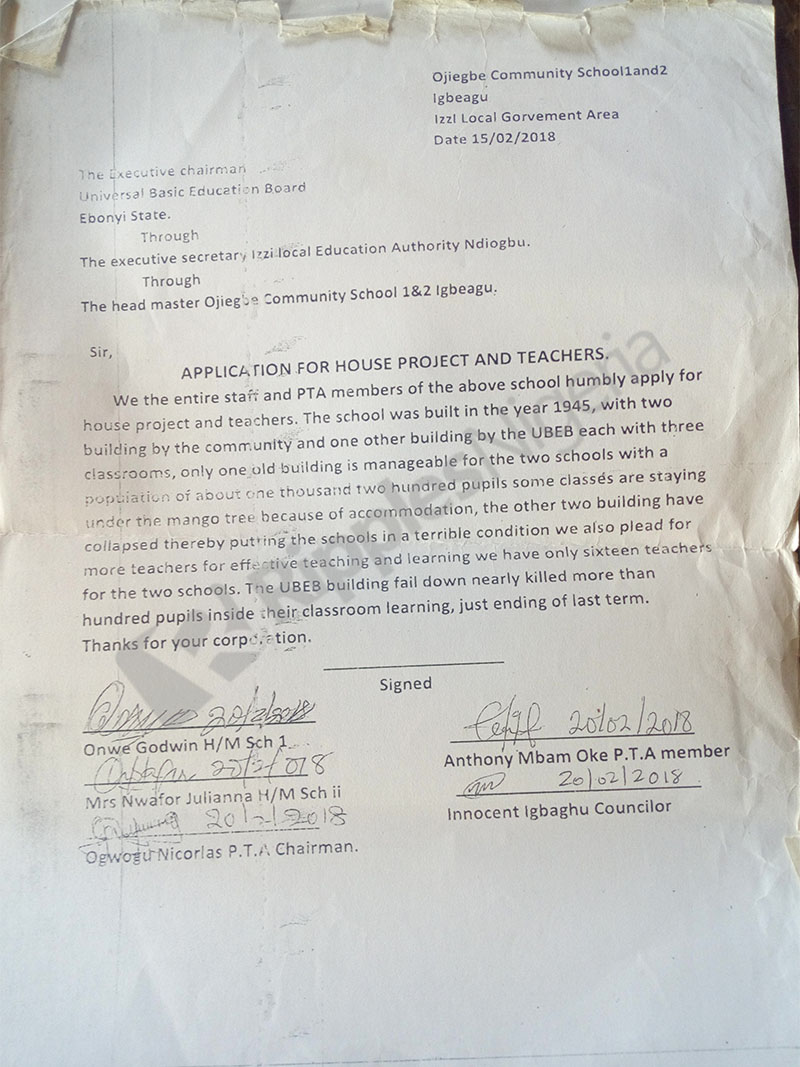
A letter Ojiegbe Primary School 1 and 2 sent to the Ebonyi State Universal Basic Education Board to provide teachers and construct a building
The school, established in 2007 has two buildings. One was uncompleted and the other dilapidated with no windows or doors, while the floors are not cemented.
“We just have two teachers here. I am a community teacher who is being paid N7,000 by the community which is trying to complete the building so the school environment can be conducive for learning. We merge primary one and two; primary three and four and then five and six. If I want to teach primary three, for instance, I will let primary four to know the topic is for primary three. I divide the board into two and teach them. If it is something that is familiar, we carry the two classes along,” says the community teacher, Livinus Onwe.
The school building can only accommodate three classes. The headmaster does not have an office. The class is also the headmaster’s office. Despite having 86 pupils, the teachers still do not come to school daily.
Onwe said “The parents are not happy the way teachers come to school. They come once or twice a week. Teachers complain they don’t have money to transport themselves. It is the only school in Okpomoro Oshiegbe, so lack of teachers make parents withdraw their children.”
In the course of a conversation with the pupils, many of them were struggling to speak English. Despite the lack of teachers, building and writing materials in the school, another thing that annoys the kids is the lack of water to drink. “There is no water in the school. We trek for two hours to where we can get drinkable water,” laments Odinaka.
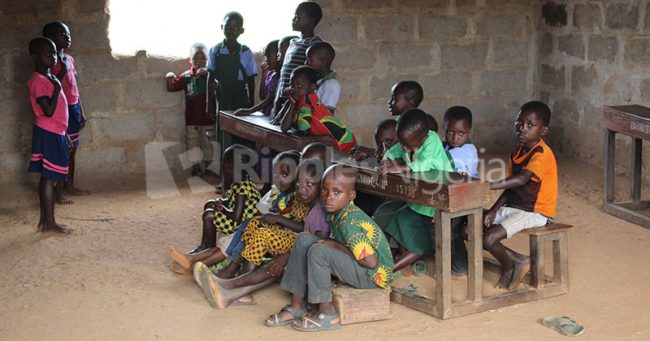
Bethel Nwoke and Kasarachi Odinaka on pink have turned teachers due to lack of teachers in Negede Migrant Primary School
At Unity Primary School, Onu-Nwankwo, Amuda in Ezza North, it is still the same. According to the teachers, it is difficult to teach.
“We have no office, chairs, and tables, and we are lacking teachers. We have only four teachers, including the headmaster. It is difficult to teach here. We use to merge the classes in two. It’s difficult because we have modules. The students’ turn up is great but we are suffering a lot, Odah Chukwu, a teacher in the school laments.
The school has one building with six classrooms but two of the classrooms have been destroyed by floods and parts of the school blocks have collapsed. Chukwu said they can’t continue to live and teach in this condition as they want the government to provide enough teachers, seats, and textbooks for the pupils.
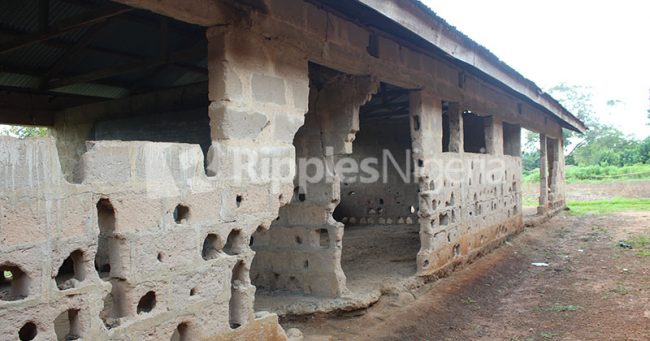
School building at Primary School in Isimkpuma, Ndieze Okpoto
Does School feeding programme motivate pupils to attend school?
One good thing that makes pupils come to school is the free food they receive when they go to school. According to Chukwu, students hardly come to school, but due to the Home Grown School Feeding Programme, pupils turn up for school. Chukwu said the teachers ensure that the programme is sustained in the village school to motivate pupils to come to school because some parents can’t feed their children.
“The woman that gives food comes every day. She can never stop coming to give them food except for the day she didn’t get the money. The food encourages the students to come to school daily,” Chukwu said.
“I like the food they give me daily and it encourages me to come to school because sometimes I find it difficult to eat at home. The food helps me and I like it, says Chiamaka Owo, a primary four pupil.
But Chukwu said the feeding programme would not have much impact if the state government can’t provide teachers and the necessary materials that can enable the children receive sound quality education.
Parent laments
When the reporter visited Community Primary School, Abonyi Okpoto in Ishielu local government established in 1955, the school building has collapsed. The community leaders had to use iron pillars to hold the roof so it does not fall off completely.
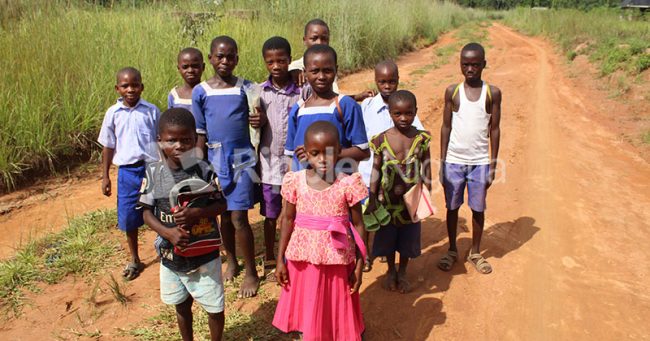
Pupils trek two hours from Abonyi Okpoto to Ndieze Okpoto to receive education
The school is the only one in Abonyi Okpoto. The teachers in the school are not from the community, so they spend much on transportation to deliver quality education. According to the community leaders, due to the distance, the teachers come twice daily. The days the teachers are not available, there won’t be school. The teachers’ quarters has collapsed and parents keep lamenting.
“I have one child in this school,” says Chukwuemeka Onwe, a member of the Parents Teachers Association (PTA). “I am happy about the school because this was where I did my primary school and I am also happy my child is schooling here too. But we lack buildings and that is the main problem because we don’t have people that can sponsor us with buildings. That is why we are begging the government to help us and employ more teachers to educate children in our village.”
“Even governors went to school and they can’t improve the state of schools. There are eight teachers in the school and the challenge is the distance the teachers take from their houses to the school. The teachers are complaining and we need more teachers. There are teachers’ quarters but the building has collapsed and they can’t stay there any longer. The classrooms are open. The building blocks have collapsed. There are many children in Abonyi Okpoto going to school, but lack of teachers and classrooms is hindering their educational development,” he continued.
Teachers go to school by shift
He lamented that the school feeding program is not existing in the school. Due to lack of teachers and the long distance it takes them to get to the school, “Teachers now come to school by shift ‒ one teacher today and another tomorrow.”
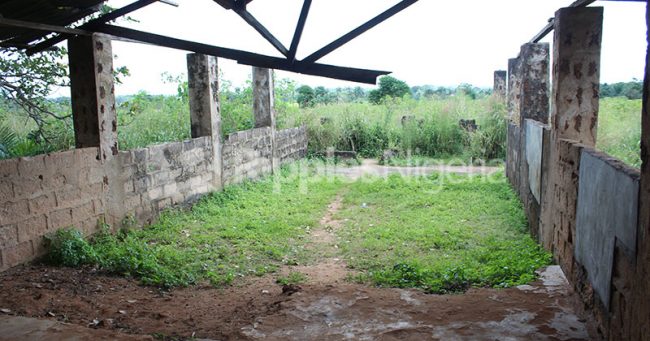
Collapse and abandoned classroom at Primary School Isimkpuma, Ndieze Okpoto in Ishielu
At Primary school Isimkpuma, Ndieze Okpoto, in Ishielu local government, the headmistress and assistant headmistress offices are outside behind one of the school’s dilapidated buildings. They situated their tables and chairs outside to attend to parents and visitors.
When asked why the heads’ seats are outside, one of the teachers who didn’t want to be named said at the class the mistresses made their offices, they are being attacked by bats. “The building is no longer strong and bats dwell there and they are all afraid of Ebola,” she said.
The two mistresses were not in school as at the time the reporter visited. But the female teacher confirmed that teachers don’t come to school daily because of distance. “We come twice in a week,” she said.
From Ishielu local government, the reporter proceeded to Onicha local government where he visited two community schools in Aba-Omege. The situation in Community Primary School, Okaria, and Okworike Community Primary School are not different from the previous ones.
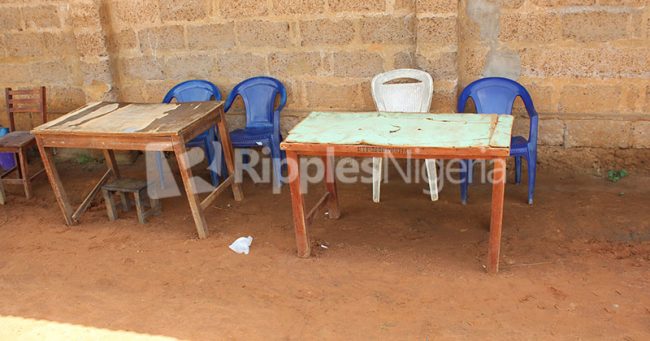
Head mistresses of Primary School Isimkpuma, Ndieze Okpoto in Ishielu use outside as ofices due to the dilapidating state of the building that enable bats visit it
The major challenges affecting these two schools are lack of teachers and infrastructure. According to the assistant headmistress of the school in Okaria, Igwe Anulika, “We don’t have enough teachers and some of our desks are spoilt. We don’t have enough textbooks. It is affecting the pupils and teachers. We are only two teachers here and we merged three classes. One teacher teaches three classes. We went to the local government and they promised to employ teachers but we haven’t seen anyone.”
In Okworike, the headmistress who is not supposed to be teaching does so to cover up for the lack of teachers in the school. According to Mrs. Evelyn Egidi, “There are only two teachers from primary one to six. Our buildings are uncompleted. Children seat on the floor. We have no seats. We don’t have a module. The children in the community go to school but due to lack of teachers, parents withdraw their children to private schools and it’s sad we decrease every day. We have written to SUBEB about lack of teachers but we have not heard from them.”
These schools have been facing various challenges for over five years.
“Village primary schools are in a terrible state”
The state of the schools in Ebonyi infuriates Salt It Empowerment Network, a non-governmental organization that empowers students across the state. “The government is not doing its best in the development of primary education, says the president, Christopher Ukpabi.
“What I have seen in the village schools is terrible. The government concentrates on primary schools in towns alone. They put 20 teachers in a school in town and when you go to the village, you will see two teachers, and there is no infrastructure. They focus on urban areas leaving the local areas,” he lamented.
He said it is only in Ebonyi state he has seen for the first time that two classes are being merged with one teacher handling two classes at the same time.
“The state government should recruit more teachers because graduates are leaving the university without work. They should make education possible in the village schools. This administration is not the best in favouring primary schools in Ebonyi state,” he continued.
The schools should not remain in ruins if the state government wants to reduce the number of children out of school. Despite the huge allocations to education in the state, there is no sign of the development of education in the state, especially in rural areas.
Where is the huge money allocated to Education and SUBEB?
In its 2018 budget provisions, the state government allocated N2.3 billion to the Ministry of Education and allocated N2.4 billion to the Ebonyi State Universal Basic Education Board. In 2017, the state government allocated N2.2 billion to the Ministry of Education and allocated N2.3 billion to the Ebonyi State Universal Basic Education Board.
The Universal Basic Education Commission (UBEC) has been releasing matching grants to state governments since its creation in 2005. According to the document on UBEC website, in 2017, UBEC released a matching grant of N1.28 billion to the Ebonyi state government. In 2018, it released N982 million to the same government. From 2005, the state has received N11.5 billion from UBEC as matching grants.
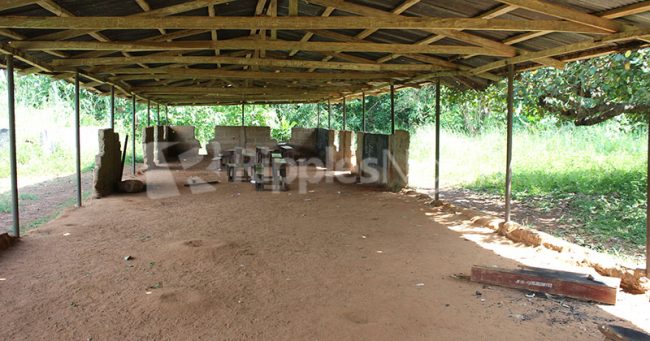
Collapse and abandoned classroom at Primary School Isimkpuma, Ndieze Okpoto in Ishielu 2
With these budgetary provisions, schools in the state should not be in shambles. Where has the money gone to? This reporter tried to speak with the SUBEB executive chairman, Chief Hyacinth Ikpor, and the state commissioner for education, Hon. Sabinus Nwankwoegu, but they refused to speak on the state of education in the state after several calls.
After visiting the Executive chairman of SUBEB in his office along Enugu-Abakaliki expressway, he walked the reporter out. The commissioner, on the other hand, kept postponing speaking with the reporter.
While the state government is building standard model primary schools in the state’s capital and major towns, primary schools in the rural areas remain in shambles.
A primary five pupil of Unity Primary School Onu-Nwankwo Ogechi Odah said she loves education. “I want to be a leader tomorrow but lack of seats, teachers, and books is not making me to learn more.”
This investigative report was supported by the Wole Soyinka Centre for Investigative Journalism (WSCIJ) Regulators Monitoring Programme (REMOP) for the Education Sector.



